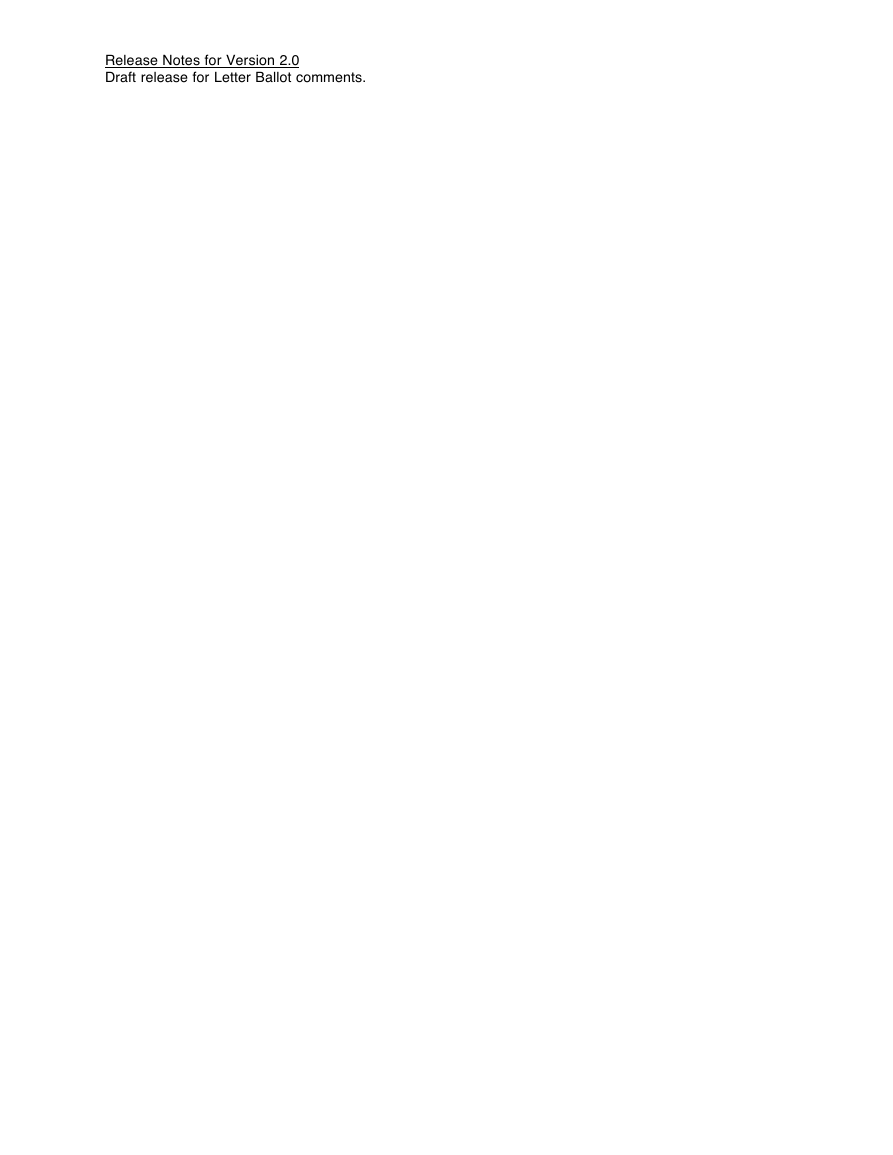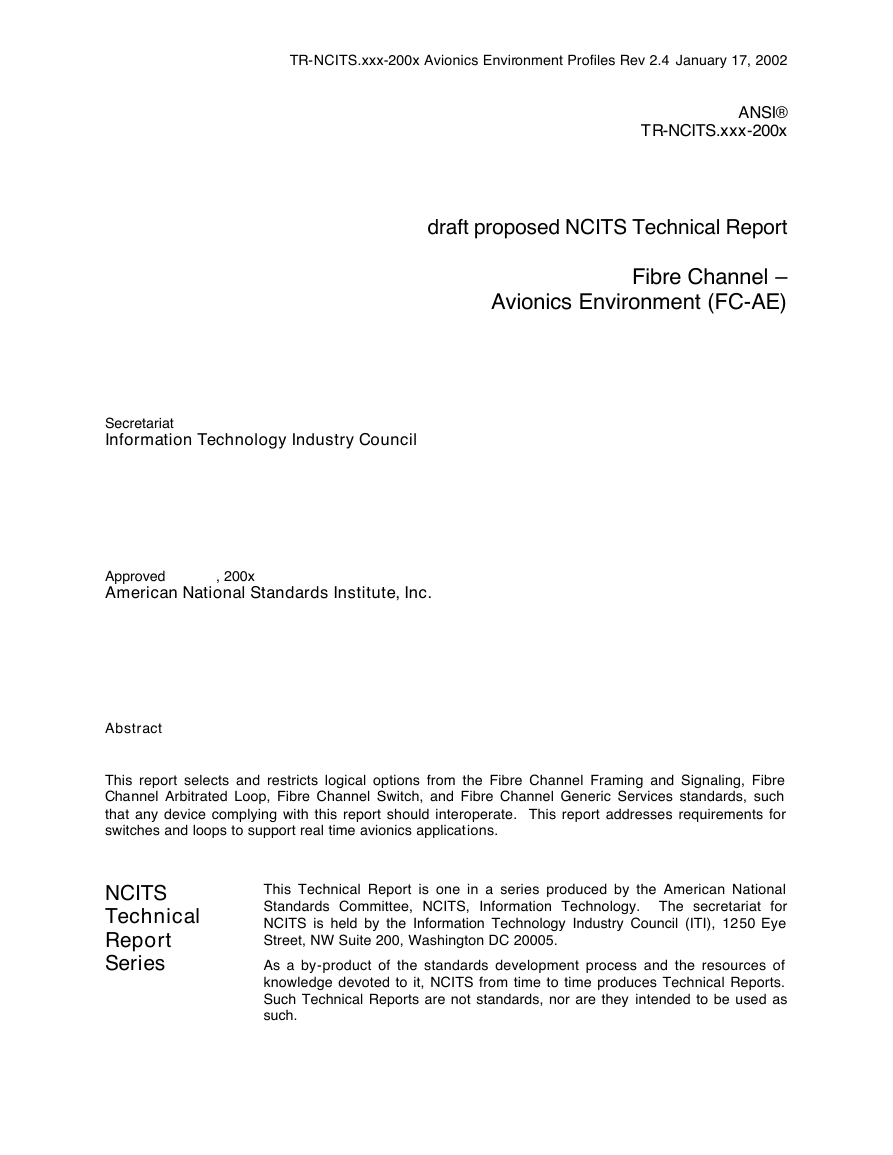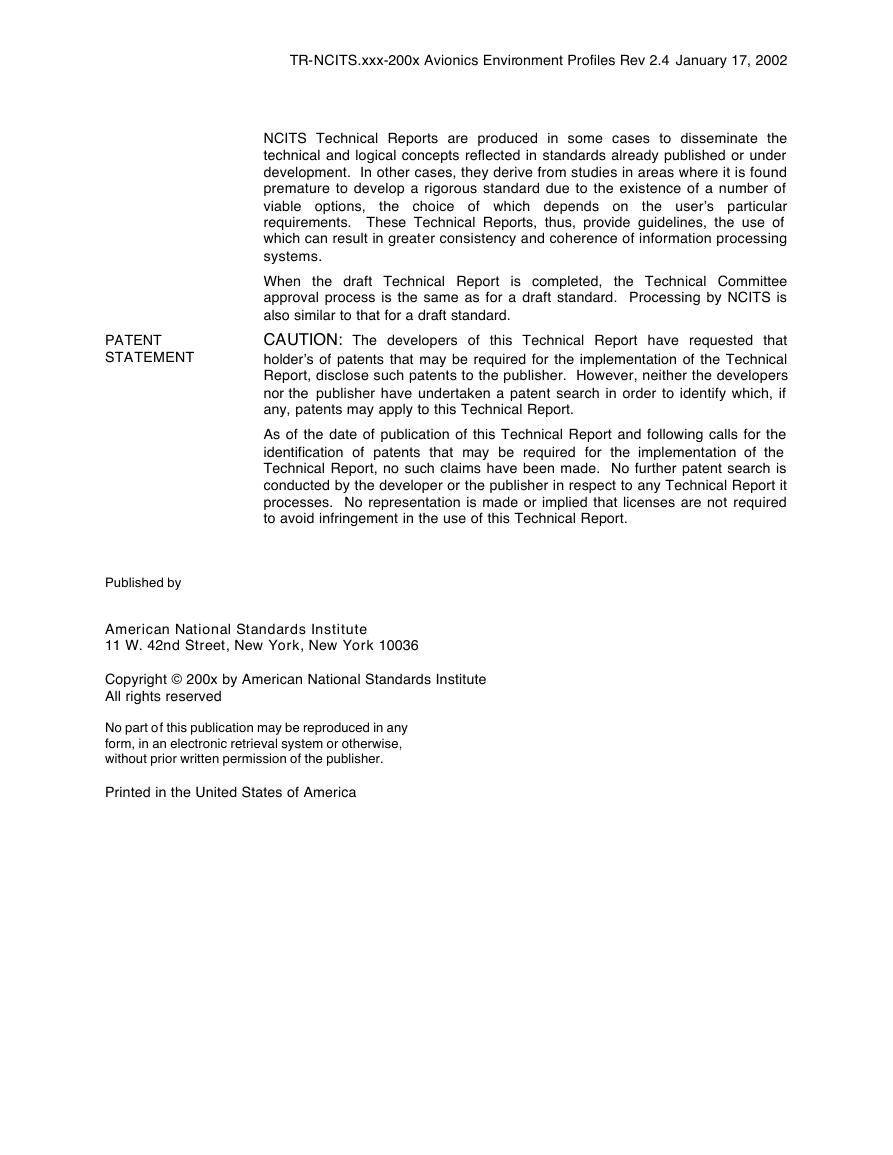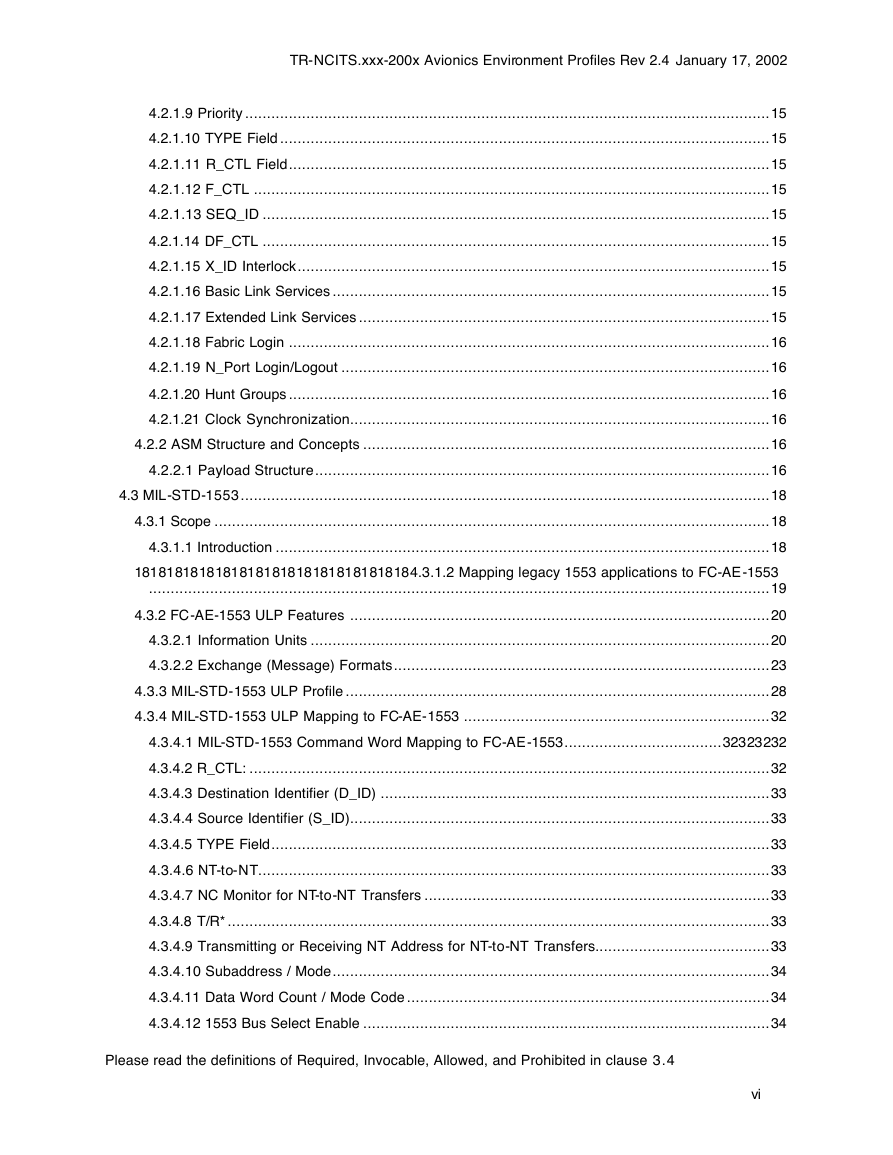Copies of this document may be purchased from: TR-NCITS.xxx-200x
Global Engineering, 15 Inverness Way East, T11/Project 2009-
DT/Rev2.2Englewood, CO 80112-5704
Phone: (800) 854-7179 or (303) 793-2181 Fax: (303) 792-2192
T11/01-238v6
(FC-AE)
REV 2.4
FIBRE CHANNEL
AVIONICS ENVIRONMENT
NCITS working draft proposed
Technical Report
January 17, 2002
Secretariat: Information Technology Industry Council
NOTE:
This is a working draft American National Standard of Accredited Standards Committee NCITS.
As such this is not a completed standard. The T11 Technical Committee or anyone else may
modify this document as a result of comments received anytime, or during a future public review
and its eventual approval as a Standard. Use of the information contained herein is at your own
risk.
Permission is granted to members of NCITS, its technical committees, and their associated task
groups to reproduce this document for the purposes of NCITS standardization activities without
further permission, provided this notice is included. All other rights are reserved. Any
duplication of this document for commercial or for-profit use is strictly Prohibited.
POINTS OF CONTACT:
Kumar Malvalli (T11 Chairman)
Brocade Communications
1901 Guadalupe Parkway
San Jose, CA 95131
Phone: (408) 487-8156
Fax: (408) 524-8601
E-Mail: kumar@brocade.com
Craig Carlson (TG T11.3 Chairman)
Qlogic
6321 Bury Drive
Eden Prairie, MN 55346
(952) 932-4064
Fax: (952) 932-4037
E-Mail: craig.carlson@qlogic.com
Ed Grivna (T11 Vice Chairman)
Cypress Semiconductor
2401 East 86th Street
Bloomington, MN 55425
(612) 851-5046
Fax: (612) 851-5087
E-Mail: elg@cypress.com
Michael S. Foster (FC-AE Chairman)
Boeing
P.O. Box 3999, M/S 5X-34
Seattle, WA 98124
(253) 931-2613
Fax: (253) 931-6585
E-Mail: michael.s.foster@boeing.com
�
Release Notes for Version 2.0
Draft release for Letter Ballot comments.
�
TR-NCITS.xxx-200x Avionics Environment Profiles Rev 2.4 January 17, 2002
ANSI®
TR-NCITS.xxx-200x
draft proposed NCITS Technical Report
Fibre Channel –
Avionics Environment (FC-AE)
Secretariat
Information Technology Industry Council
Approved , 200x
American National Standards Institute, Inc.
Abstract
This report selects and restricts logical options from the Fibre Channel Framing and Signaling, Fibre
Channel Arbitrated Loop, Fibre Channel Switch, and Fibre Channel Generic Services standards, such
that any device complying with this report should interoperate. This report addresses requirements for
switches and loops to support real time avionics applications.
NCITS
Technical
Report
Series
This Technical Report is one in a series produced by the American National
Standards Committee, NCITS, Information Technology. The secretariat for
NCITS is held by the Information Technology Industry Council (ITI), 1250 Eye
Street, NW Suite 200, Washington DC 20005.
As a by-product of the standards development process and the resources of
knowledge devoted to it, NCITS from time to time produces Technical Reports.
Such Technical Reports are not standards, nor are they intended to be used as
such.
�
TR-NCITS.xxx-200x Avionics Environment Profiles Rev 2.4 January 17, 2002
the choice of which depends on
NCITS Technical Reports are produced in some cases to disseminate the
technical and logical concepts reflected in standards already published or under
development. In other cases, they derive from studies in areas where it is found
premature to develop a rigorous standard due to the existence of a number of
viable options,
the user’s particular
requirements. These Technical Reports, thus, provide guidelines, the use of
which can result in greater consistency and coherence of information processing
systems.
When the draft Technical Report is completed, the Technical Committee
approval process is the same as for a draft standard. Processing by NCITS is
also similar to that for a draft standard.
CAUTION: The developers of this Technical Report have requested that
holder’s of patents that may be required for the implementation of the Technical
Report, disclose such patents to the publisher. However, neither the developers
nor the publisher have undertaken a patent search in order to identify which, if
any, patents may apply to this Technical Report.
As of the date of publication of this Technical Report and following calls for the
identification of patents that may be required for the implementation of the
Technical Report, no such claims have been made. No further patent search is
conducted by the developer or the publisher in respect to any Technical Report it
processes. No representation is made or implied that licenses are not required
to avoid infringement in the use of this Technical Report.
PATENT
STATEMENT
Published by
American National Standards Institute
11 W. 42nd Street, New York, New York 10036
Copyright © 200x by American National Standards Institute
All rights reserved
No part of this publication may be reproduced in any
form, in an electronic retrieval system or otherwise,
without prior written permission of the publisher.
Printed in the United States of America
�
TR-NCITS.xxx-200x Avionics Environment Profiles Rev 2.4 January 17, 2002
Contents
1. Introduction ....................................................................................................................................1
2. Normative References .....................................................................................................................1
2.1 Approved references ..................................................................................................................2
2.2 References under development ..................................................................................................2
2.3 Other references ........................................................................................................................2
3. Definitions and conventions .............................................................................................................3
3.1 Definitions .................................................................................................................................3
3.1.1 Implicit LIP ..........................................................................................................................3
3.1.2 Anonymous Subscriber Messaging (ASM).............................................................................3
3.1.3 Fibre Channel Lightweight Protocol (FCLP)...........................................................................3
3.1.4 Remote Direct Memory Access (RDMA)................................................................................3
3.1.5 Network Controller (NC).......................................................................................................3
3.1.6 Network Terminal (NT) .........................................................................................................3
3.1.7 Command Frame.................................................................................................................3
3.1.8 Data Frames .......................................................................................................................3
3.1.9 Status Frame.......................................................................................................................3
3.1.10 Bus Identifier (B_ID)...........................................................................................................3
3.1.11 Others ...............................................................................................................................3
3.2 Editorial conventions ..................................................................................................................4
3.2.1 Binary notation ....................................................................................................................4
3.2.2 Hexadecimal notation ..........................................................................................................4
3.3 Abbreviations and acronyms.......................................................................................................4
3.3.1 Acronyms and abbreviations ................................................................................................4
3.4 Applicability and use of this document .........................................................................................5
4. Profiles ...........................................................................................................................................7
4.1 Scope .......................................................................................................................................7
4.2 Anonymous Subscriber Messaging (ASM) ...................................................................................7
4.2.1 ASM Basic Services.............................................................................................................7
4.2.1.1 Link Protocols..............................................................................................................12
4.2.1.2 Arbitrated Loop............................................................................................................12
4.2.1.3 Addressing ..................................................................................................................14
4.2.1.4 Class 1 .......................................................................................................................14
4.2.1.5 Class 2 .......................................................................................................................14
4.2.1.6 Class 3 .......................................................................................................................14
4.2.1.7 Class 4 .......................................................................................................................14
4.2.1.8 Class 6 .......................................................................................................................14
Please read the definitions of Required, Invocable, Allowed, and Prohibited in clause 3.4
v
�
TR-NCITS.xxx-200x Avionics Environment Profiles Rev 2.4 January 17, 2002
4.2.1.9 Priority ........................................................................................................................15
4.2.1.10 TYPE Field ................................................................................................................15
4.2.1.11 R_CTL Field..............................................................................................................15
4.2.1.12 F_CTL ......................................................................................................................15
4.2.1.13 SEQ_ID ....................................................................................................................15
4.2.1.14 DF_CTL ....................................................................................................................15
4.2.1.15 X_ID Interlock............................................................................................................15
4.2.1.16 Basic Link Services ....................................................................................................15
4.2.1.17 Extended Link Services ..............................................................................................15
4.2.1.18 Fabric Login ..............................................................................................................16
4.2.1.19 N_Port Login/Logout ..................................................................................................16
4.2.1.20 Hunt Groups ..............................................................................................................16
4.2.1.21 Clock Synchronization................................................................................................16
4.2.2 ASM Structure and Concepts .............................................................................................16
4.2.2.1 Payload Structure........................................................................................................16
4.3 MIL-STD-1553.........................................................................................................................18
4.3.1 Scope ...............................................................................................................................18
4.3.1.1 Introduction .................................................................................................................18
18181818181818181818181818181818184.3.1.2 Mapping legacy 1553 applications to FC-AE-1553
..............................................................................................................................................19
4.3.2 FC-AE-1553 ULP Features ................................................................................................20
4.3.2.1 Information Units .........................................................................................................20
4.3.2.2 Exchange (Message) Formats......................................................................................23
4.3.3 MIL-STD-1553 ULP Profile .................................................................................................28
4.3.4 MIL-STD-1553 ULP Mapping to FC-AE-1553 ......................................................................32
4.3.4.1 MIL-STD-1553 Command Word Mapping to FC-AE-1553....................................32323232
4.3.4.2 R_CTL: .......................................................................................................................32
4.3.4.3 Destination Identifier (D_ID) .........................................................................................33
4.3.4.4 Source Identifier (S_ID)................................................................................................33
4.3.4.5 TYPE Field..................................................................................................................33
4.3.4.6 NT-to-NT.....................................................................................................................33
4.3.4.7 NC Monitor for NT-to-NT Transfers ...............................................................................33
4.3.4.8 T/R* ............................................................................................................................33
4.3.4.9 Transmitting or Receiving NT Address for NT-to-NT Transfers........................................33
4.3.4.10 Subaddress / Mode....................................................................................................34
4.3.4.11 Data Word Count / Mode Code ...................................................................................34
4.3.4.12 1553 Bus Select Enable .............................................................................................34
Please read the definitions of Required, Invocable, Allowed, and Prohibited in clause 3.4
vi
�
TR-NCITS.xxx-200x Avionics Environment Profiles Rev 2.4 January 17, 2002
4.3.4.13 1553 Bus B/A*...........................................................................................................35
4.3.4.14 RT Address for MIL-STD-1553 RT..............................................................................35
4.3.4.15 FC-AE-1553 Mode Codes ..........................................................................................35
4.3.4.16 MIL-STD -1553B Status Word Mapping to FC-AE-1553 ................................................37
4.3.4.17 MIL-STD -1553 RT Addresses .....................................................................................39
4.3.4.18 No Response by MIL-STD-1553 RT (bit 6 of Status Frame Header Word 9) ..................39
4.3.4.19 1553 RT Format Error (bit 5 of Status Frame Header Word 9) ......................................40
4.3.5 FC-FS and FC-AL-2 Features for FC-AE-1553 ....................................................................40
4040404.3.5.1 Fabric-Specific Features .............................................................................................44
4.3.5.2 Arbitrated Loop-Specific Features .................................................................................45
4.3.5.3 N_Port Login ...............................................................................................................46
4.3.5.4 FC-FS Header Fields ...................................................................................................47
4.3.5.5 Fabric Reject/Fabric Busy ............................................................................................48
4.3.5.6 Port Reject/Port Busy...................................................................................................48
4.3.5.7 Basic Link Services ......................................................................................................48
4.3.5.8 Extended Link Services ................................................................................................48
4.3.5.9 Well Known Address Support .......................................................................................49
4.4 Virtual Interface (VI) .................................................................................................................50
4.4.1 FC-VI Features for FC-AE-VI..............................................................................................50
4.4.1.1 Connection Models ......................................................................................................51
4.4.1.2 Transfer Models ..........................................................................................................51
4.4.1.3 FCVI_Attributes ...........................................................................................................51
4.4.1.4 FCVI_Addressing ........................................................................................................52
4.4.2 FC-FS and FC-AL2 Features for FC-AE-VI..........................................................................52
4.4.2.1 Link Protocols..............................................................................................................58
4.4.2.2 Arbitrated Loop............................................................................................................58
4.4.2.3 Fabric Login ................................................................................................................59
4.4.2.4 N_Port Login ...............................................................................................................60
4.4.2.5 Fabric Reject/Fabric Busy ............................................................................................61
4.4.2.6 Port Reject/Port Busy...................................................................................................61
4.4.2.7 Well Known Address Support .......................................................................................61
4.4.2.8 Basic Link Services ......................................................................................................62
4.4.2.9 Extended Link Services ................................................................................................62
4.5 Fibre Channel Lightweight Protocol (FCLP)...............................................................................63
4.5.1 FC-AE-FCLP Command Primitives .....................................................................................63
4.5.1.1 Setup Channel Command ............................................................................................63
4.5.1.2 Setup Channel Acknowledgement ................................................................................64
Please read the definitions of Required, Invocable, Allowed, and Prohibited in clause 3.4
vii
�
TR-NCITS.xxx-200x Avionics Environment Profiles Rev 2.4 January 17, 2002
4.5.1.3 Send Data Command ..................................................................................................64
4.5.1.4 Close Channel Command ............................................................................................65
4.5.1.5 Return APIDs Command ..............................................................................................65
4.5.2 FCP Features for FC-AE-FCLP ..........................................................................................65
4.5.2.1 Process Login Service Parameters ...............................................................................67
4.5.2.2 Process Login Service Response Parameters ...............................................................67
4.5.2.3 FCP Command IU .......................................................................................................68
4.5.2.4 FCP Transfer Ready IU................................................................................................68
4.5.2.5 FCP Data IU................................................................................................................68
4.5.2.6 FCP Response IU........................................................................................................68
4.5.3 FC-FS and FC-AL2 Features for FC-AE-FCLP ....................................................................69
4.5.3.1 Link Protocols..............................................................................................................74
4.5.3.2 Arbitrated Loop............................................................................................................74
4.5.3.3 Fabric Login ................................................................................................................75
4.5.3.4 N_Port Login ...............................................................................................................75
4.5.3.5 Well Known Address Support .......................................................................................76
4.5.3.6 Basic Link Services ......................................................................................................76
4.5.3.7 Extended Link Services ................................................................................................76
4.6 Remote Direct Memory Access (RDMA)....................................................................................77
4.6.1 RDMA Enhancement to FCP ..............................................................................................77
4.6.2 FCP Features for FC-AE-RDMA .........................................................................................77
4.6.2.1 Process Login Service Parameters ...............................................................................79
4.6.2.2 FCP Command IU .......................................................................................................80
4.6.2.3 FCP Transfer Ready IU................................................................................................80
4.6.2.4 FCP Data IU................................................................................................................80
4.6.2.5 FCP Response IU........................................................................................................80
4.6.3 FC-FS and FC-AL2 Features for FC-AE-RDMA ...................................................................82
4.6.3.1 Link Protocols..............................................................................................................88
4.6.3.2 Arbitrated Loop............................................................................................................88
4.6.3.3 Fabric Login ................................................................................................................89
4.6.3.4 N_Port Login ...............................................................................................................90
4.6.3.5 Fabric Reject/Fabric Busy ............................................................................................91
4.6.3.6 Port Reject/Port Busy...................................................................................................91
4.6.3.7 Well Known Address Support .......................................................................................91
4.6.3.8 Basic Link Services ......................................................................................................91
4.6.3.9 Extended Link Services ................................................................................................91
Annex A ...........................................................................................................................................93
Please read the definitions of Required, Invocable, Allowed, and Prohibited in clause 3.4
viii
�
















 2023年江西萍乡中考道德与法治真题及答案.doc
2023年江西萍乡中考道德与法治真题及答案.doc 2012年重庆南川中考生物真题及答案.doc
2012年重庆南川中考生物真题及答案.doc 2013年江西师范大学地理学综合及文艺理论基础考研真题.doc
2013年江西师范大学地理学综合及文艺理论基础考研真题.doc 2020年四川甘孜小升初语文真题及答案I卷.doc
2020年四川甘孜小升初语文真题及答案I卷.doc 2020年注册岩土工程师专业基础考试真题及答案.doc
2020年注册岩土工程师专业基础考试真题及答案.doc 2023-2024学年福建省厦门市九年级上学期数学月考试题及答案.doc
2023-2024学年福建省厦门市九年级上学期数学月考试题及答案.doc 2021-2022学年辽宁省沈阳市大东区九年级上学期语文期末试题及答案.doc
2021-2022学年辽宁省沈阳市大东区九年级上学期语文期末试题及答案.doc 2022-2023学年北京东城区初三第一学期物理期末试卷及答案.doc
2022-2023学年北京东城区初三第一学期物理期末试卷及答案.doc 2018上半年江西教师资格初中地理学科知识与教学能力真题及答案.doc
2018上半年江西教师资格初中地理学科知识与教学能力真题及答案.doc 2012年河北国家公务员申论考试真题及答案-省级.doc
2012年河北国家公务员申论考试真题及答案-省级.doc 2020-2021学年江苏省扬州市江都区邵樊片九年级上学期数学第一次质量检测试题及答案.doc
2020-2021学年江苏省扬州市江都区邵樊片九年级上学期数学第一次质量检测试题及答案.doc 2022下半年黑龙江教师资格证中学综合素质真题及答案.doc
2022下半年黑龙江教师资格证中学综合素质真题及答案.doc